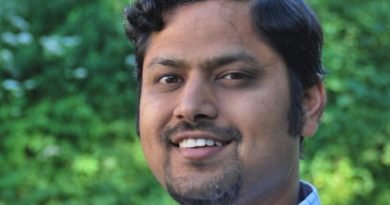Dr. Praveen Kumar Jha
New Delhi: Healthcare could be a ‘million dollar question’ for most countries, I will just give my two cents based on my dabbling through the different scenarios. While USA was mostly private healthcare (before the Obamacare eyewash), India largely had a hybrid system, and Norway has (so called) one of the best public healthcare. As a doctor, I found all of them quite apt and adaptable. But, as far as patients are concerned, all of them seem flawed. We are yet to witness the ‘best healthcare for all’ model. It is simply because there is no ‘rule of thumb’ and healthcare needs to be customised according to socio-economic and geographical attributes of the land.
First and foremost, we must accept the fact that healthcare or any service could never be ‘free’.It would come at a cost, and healthcare would demand a huge cost-burden. It is another issue how it
is extracted out of your pocket.
In a private healthcare, one would pay directly to the service-provider or to the insurance companies.In a public healthcare, a corpus would be generated
through tax collections and revenues. In a hybrid system, it would be a combination of both. The practical aspect of this cost-burden is the judicial utilization. And this would apply to any kind of healthcare. If it is a state supported healthcare, the patients can’t keep filling up the hospital beds, simply saying, “We pay the taxes, the government must pay for it”. If you consider Norwegian healthcare, hospital beds are strongly restricted to the needy people. And, this ‘needy’ term is dictated by the healthcare professionals and not by the patients.
This may sound nagging to a patient with severe back-pain, being shown the door because he isn’t needy enough, based on
investigations. It is quite similar to AIIMS refusing a needy patient or diverting to Safdarjung hospital, once infamously termed as ‘dustbin of AIIMS’.
In Norwegian healthcare, there is no
dustbin either, one would be simply bundled up back home and they have to live with whatever inexplicable pain they have.On the other hand, private healthcare is a patient-wooing industry. They are typical ‘Customer is God’ people, who would love to milk out the pockets of these gods. Of course, one would expect the best services as they keep on moving up the tab. The more you pay, better the service.
Hospitals would have crowded general wards to cozy luxury wards, where patients can chose to lie for months. One would find convicted VIPs occupying the hospitals to skip imprisonment! But, what if one can’t pay for it? India, with a huge middle and lower class burden, can’t afford to have private healthcare for all. Even richer lands like USA can’t afford it, and you would find Americans traveling across the seas to get an affordable healthcare aptly called ‘medical tourism’.
Besides, Norwegian public healthcare is also not free. A patients pays a fee share (1/3rd or more) for each out-patient visit, and then pays for investigations and medicine. This may be a bit liberalised in systems like NHS (United Kingdom), but it is never completely free. Apart from that, both the countries (Norway and UK) have heavy taxes for salaried as well as corporates. Only hospitalisation is paid by the government, but as I told that hospitalisation itself is not a ‘piece of cake’. Moreover, we must remember that entire population of Norway is even smaller than Indian cities like Bangalore. Norway uses around 10 % of its rich GDP to provide healthcare for such a small population. On the other hand, India, a country of more than a billion uses around 1 % of its GDP. USA lies in the middle at around 5 % of GDP.
Thus, only feasible healthcare model for India is a hybrid healthcare model. We indeed have a hybrid healthcare, but it needs to be organised and regulated. One of the popular narrative is India’s poor doctor:patient ratio (based on WHO data). This narrative only adds up to mushrooming private medical colleges churning out thousands of doctors every year, who are barely interested in moving to rural healthcare.
Are we really short of doctors, or the situation is a bit different?
My native city Darbhanga, a small town in Bihar, is flooded with more than 5000 qualified allopathic doctors and thousands of AYUSH physicians as well as quacks. A patient would land up at the bus-stand, and they would be transported to the health hubs spread inside the city. You would find a doctor with a large queue waiting for him, and another struggling to get even one patient. The scenario is similar in most of the Indian cities. Surgeons in small hospitals are praying to get a single patient for the day. The day I moved out of Bangalore, I was replaced that very evening.
While the city in Norway where I landed up, got its first permanent specialist radiologist, after a gap of five years! In India, one can get MRI done within hours, while the average waiting time in Norway is 3 weeks. An Indian even flew to India to get a MRI done, because he couldn’t wait in public queue. Of course he could have paid for it in one of the private diagnostic centers in Norway, but they are not a part of public healthcare as such and they cost almost thrice as much as in India.One may well argue about the need of doctors in rural India, but that’s where the question of distribution comes. Healthcare must be strictly distributed as a pyramidal system. While in India, anybody can walk into a chamber of Orthopedician, it is impossible in public health care systems as Norway. Patients have to pay umpteen of visits to the primary physician, before they can be referred to a specialist. Villages and small cities should have a self-sustained ecosystem of primary physicians. And each qualified primary physician must be assigned a fixed number of patients according to a national registry. They may chose to switch physicians once or twice in a year, but each resource should be utilized enough.
Specialists should be restricted to the district centres, and superspecialists in the state capital hub. This should be geographically assigned such that their would be minimal competition and maximum patient distribution. Medical licensing system and healthcare approval should be controlled by state, which would assure the quality of health professional. The concept of ‘good doctor-bad doctor’ or things like Asia famous and world famous surgeons should not be promoted. Let me reiterate the fact that India has enough specialists and doctors, and it is so huge that it even fills up the requirements of countries like USA and Britain. Many are willing to come back to country if the pyramidal structure is in place, and ethical practices are feasible.
State should limit its financing to a portion of primary health care, and necessary specialist care. However, it should play an important role as regulatory and advisory body for private healthcare. State should also pay for life-saving private healthcare facilities of children, poor and unemployed groups. With schemes like state health insurance, and public private partnerships (including Ayushman etc.), India is already progressing in this direction. However, quality control and equitable distribution of healthcare is a task ahead.
Lastly, I would come to the most important aspect i.e. reducing the need of healthcare. State can reduce the health burden, not by raising up huge multi-bedded hospitals, but by reducing the patients visiting them. Preventive measures are the state responsibility. Hygiene, health education and lifestyle modification should be the focus of healthcare ahead. Even the Gandhian model of health focuses on that very attribute, where he envisioned model villages with active individuals, clean hygienic practices and reducing narcotic/alcohol abuses. In present era, one may add better work environment and labour laws to assure good mental and physical health. This is one important aspect where Scandinavia or developed countries have an edge. They might not have plenty of multi-bedded hospitals and specialist facilities, but they have markedly reduced the patients visiting them.The goal of healthcare is prevention of illnesses and improving the quality of life. Treating the illnesses is not actually the real goal.
(Dr. Praveen Kumar Jha is a radiologist, columnist, and author, presently settled in Norway)









